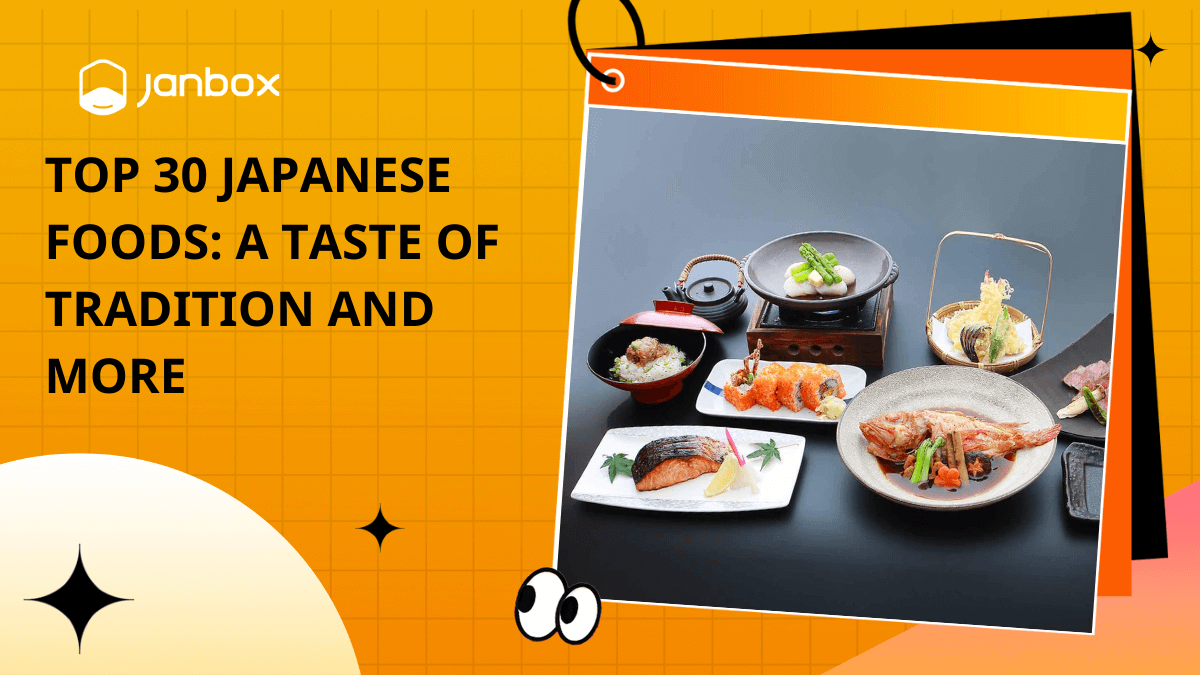There are countless and diverse types of confectionery to choose from in the intriguing realm of Japanese traditional sweets (Wagashi). These delectable sweet delights are available in a broad range of flavors, colors, and textures. This kind of art is often referred to as wagashi. What then is Japanese Wagashi? The degree of creativity that is embodied in wagashi is unparalleled. It is a form of expression that has deep significance and captures the enduring traditions of Japanese culture. Small edible works of art are created from the ingredients and they are almost too beautiful to eat.
The Origins of Japanese Sweets
Mochi, a sticky rice cake that is considered to be the country’s first processed food, is where the history of Japanese sweets begins. After the year 630, Chinese pastries known as Karagashi were introduced to Japan during the 19 times that Japanese envoys to China, known as Kentoshi, traveled to China.wa
The evolution of Japanese confectionery was also influenced by Portuguese delicacies introduced by missionaries, such as sponge cake and sugar candy. Japanese confections started to change during the Edo era, a time without civil conflicts. The majority of modern-day Japanese sweets were created during the Edo Period. Additionally, the advent of baking tools like ovens brought about by the presence of Western civilizations contributed to the popularity of baked sweets.
The List of Top 20 Japanese Traditional Sweets
You may have a variety of delicious delicacies with a cup of tea every leisurely afternoon. See the list of the name of traditional Japanese sweets below to try some interesting new foods.
1. Mochi
The little sticky rice cakes known as mochi play a significant role in Japanese food and culture. The lengthy process of pounding rice, generally the sticky Mochigome kind, until it develops into a thick and uniform paste is the first step in making mochi.
It is afterward rolled and formed into tiny circular shapes. Mochi has long been connected to Japan even though its roots may be in China. Up to the Heian period, when it became a delicacy that was frequently cooked and given at religious celebrations because people believed it brought fortune and health, it first emerged during the Yayoi period and was only relished by the elite.
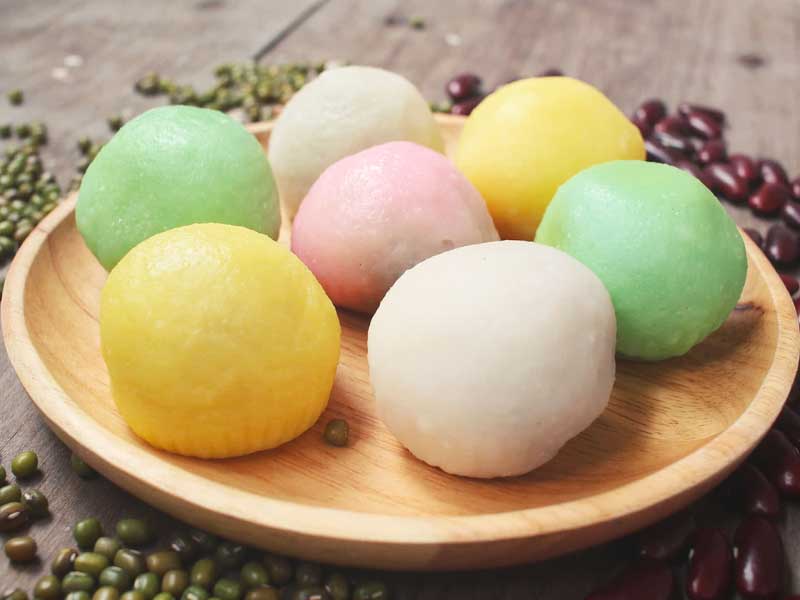
Mochi can be used in savory foods, often soups and snacks, although it is most frequently transformed into confections. Mochi is frequently dyed with food coloring to produce a variety of lovely color combinations when it is served as a dessert. The most popular candy is daifuku, circular cakes filled with various fillings including ice cream, strawberries, or the traditional red bean paste. It’s crucial to consume mochi carefully and mindfully because of its chewy texture and to take little nibbles from this sticky dessert.
2. Wagashi
Japanese wagashi sweets are often produced from organic, plant-based components including grains and azuki beans. The three types of sweets are Namagashi (fresh confectionery), Han Namagashi (half-dry confectionery), and higashi. They are commonly served with tea (dry confectionery).

The design of wagashi is what makes it unique, therefore in the spring, when the cherry blossoms are in full bloom, the manufacturers fashion wagashi into the form of cherry blossoms using cherry petals or leaves. Since these confections have their roots in the Yayoi Era, when all that was available was fresh fruit, nuts, and berries, wagashi has been inspired by Chinese techniques for processing grains.
3. Dorayaki
Dorayaki, a delectable snack made of a sweet filling sandwiched between two fluffy pancakes, is unquestionably one of the most well-known wagashi (traditional Japanese confections) varieties. Despite having ancient origins and getting its name from the Japanese word for Gong (Dora), which the dorayaki shape resembles, the famous delicacy apparently first appeared as a sandwich in the early 1900s by a Tokyo-based confectionary known as Usagiya.
Since then, the name “dorayaki” has been used to describe two little pancake-like patties that have been joined together with the so-called Anko or sweet azuki red bean paste. Typically, honey, a small amount of mirin, a sweet rice wine, and even a tiny bit of soy sauce are added to the pancake batter to give it a taste.

While most manga and anime fans may recall it as the preferred snack of the blue robot-cat Doraemon, a manga series character from the 1970s, dorayaki is now again becoming more and more popular as part of an overall Japanese wave of nostalgia for foods from the Showa Era (1926-1989).
Additionally, in addition to the traditional red bean filling, there are many other flavors available today, including white bean paste, matcha green tea paste, sweet potato, and chestnut cream, or you can choose a filling for your dorayaki that is custard cream, whipped cream, or a decadent chocolate and strawberry combination for an interesting East-meets-West snack.
4. Dango
Traditional Japanese sweets called Dango are served as bamboo-skewered dumplings made of rice flour and sugar. Other types of flour (like potato or millet flour) or various ingredients (like green tea or azuki bean paste) are used in certain regionally-specific variations.
Since the Jomon era, when the wild nuts were ground into flour and utilized to create the meal, Dango has been eaten throughout Japan. There are many different types of Dango available nowadays, including Hanami, Anko, Cha, Kuri, Niku, Teppanyaki, Denpun, Bocchan, and Sasa Dango.
Like the majority of Dango sweets, the most well-known variant is known as Mitarashi Dango; it is coated with a sweet, soy sauce-based syrup and is typically served with green tea.
5. Taiyaki
Azuki sweet bean paste is used to fill the flour-based fish-shaped cake known as Taiyaki, which is frequently eaten as a snack. It is frequently offered at most Taiyakivendors during any winter celebration in Japan, generally served warm. The majority of people think that this sweet delicacy first appeared in Tokyo during the Meiji period, yet in 1976, Taiyakishot to fame thanks to the release of the adored children’s song Oyoge!
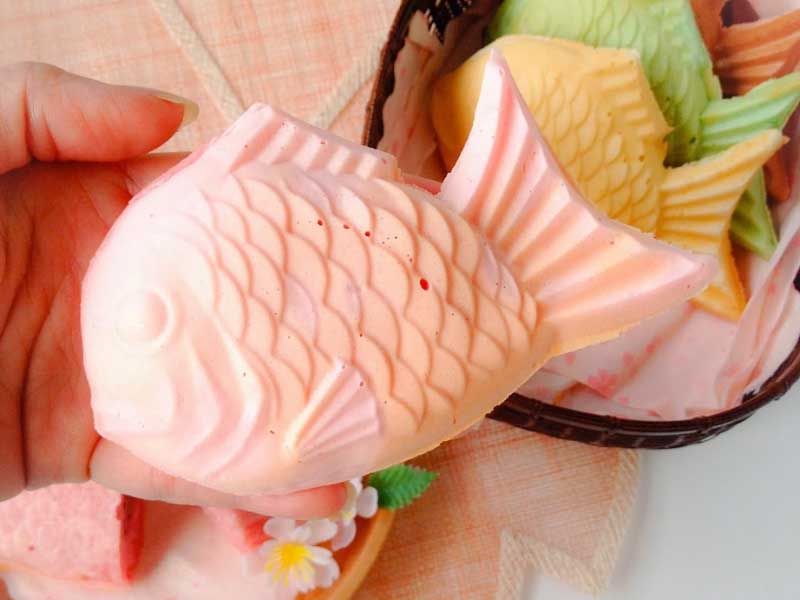
Swim, Taiyaki, says Taiyaki-kun. Despite the fact that there are many various tastes and variations of Taiyakiavailable today, the standard Taiyaki is still a favorite since it is considered the best Taiyakiis distinguished by a crisp shell that has been cooked to a golden brown hue.
6. Namagashi
Namagashi, which translates to “raw sweets,” is a form of wagashi and a Japanese confection made from organic materials such as fruit jellies or sweetened bean paste. Its lovely pattern, which incorporates seasonal and organic forms like flowers and leaves, has led to its classification as an edible work of art.

Because it is the most delicate of all wagashi varieties and is prepared daily, namagashi is particularly well-liked at Japanese tea ceremonies. It should be enjoyed as soon as it is produced, ideally with a cup of reviving matcha tea. In Japan nowadays, every confectionary shop often offers its own assortment of distinctive, exquisite, and seasonal namagashi.
>>> Read more: Top 12 Best Japanese Kit Kat Flavors You Must Try Now
7. Amanattō
Azuki or black soybeans are typically used in Amanattō, a traditional Japanese dry dessert, which also includes sugar and sugar syrup. When sugar was first made available in Japan in the early 1860s, it is thought that the dessert was born.

Hosoda Yasubei created the first Amanattō, and shortly after, he launched a wagashi shop in Tokyo. The original Amanattō was made from azuki beans, Sasage cowpeas, and Soramame green beans. Since it is frequently offered with tea in many Japanese elderly homes, Amanattō is now very well-liked in Japan, especially among the older generations. The key factor contributing to the somewhat sweet flavor of Hokkaido’s sekihan red rice is the frequent usage of Amanattō during the festival season.
8. Imagawayaki
Imagawayaki is a popular Japanese snack with several different names that are eaten all around the nation. The meal consists of a cake-like sponge with a sweetened red bean filling within. The cake is given its customary round shape and a crunchy exterior thanks to the thick, egg-based batter being poured into specific pans.

Imagawayaki, a similar fish-shaped dessert, is thought to have initially originated in the 18th century as a precursor to Taiyaki. Due to its widespread appeal, this classic dessert is now available with a variety of fillings, such as white beans, custards with a vanilla taste, fruit, or even cheese.
9. Mushi Pan
Japanese steamed buns known as Mushi pan are distinguished by their soft and light texture and a wide range of flavors. They are usually steamed in little molds, similar to those used to make muffins, and are made using a basic base of flour, sugar, baking powder, and eggs.

After the Second World War, when wheat flour was increasingly prevalent in Japanese households, buns gained popularity. One of the most well-known types of Mushi pan, along with chocolate, banana, mango, matcha, azuki, and many others, is sweet potato (satsumaimo), which was initially used as a sweetener instead of sugar.
>>Read more: 15+ Unique Japanese Vegetables you may not find it anywhere.
10. Mizu manjū
A distinctive Japanese sweet called Mizu manjū is created with the starchy Kuzuko powder. Kuzuko, sugar, and water combine to produce an almost translucent confection with a jelly-like consistency. The filling for Mizu manjūis typically sweetened red bean paste, however, there are many modern variants. This light dessert with a watery consistency is typically savored as a cool summer treat.

11. Gyūhi
Gyūhiis the name for the softer, sweeter, and more delicate variation of traditional Japanese mochi. It is created using pounded glutinous rice or glutinous rice flour and is similar to mochi. It is frequently shaped into different forms and colored with a range of synthetic and natural food colorings since it mimics flexible dough. It is an essential component of Japanese cuisine even though it is not as frequently consumed as mochi desserts.
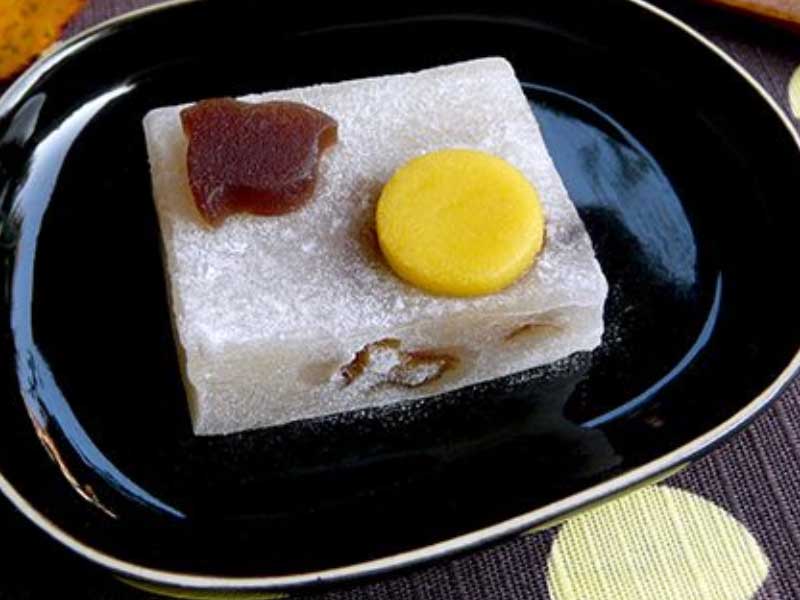
12. Mitsumame
A well-known Japanese summer treat called Mitsumame is created with jelly and black sugar syrup. It frequently comes with a variety of fruits and other hydrating ingredients. Each Mitsumame has a base of transparent jelly cubes manufactured with agar-agar, a thickening ingredient made from seaweed.
Similar to gelatin, agar-agar is used to harden water or other liquids into a mass that may then be sliced or formed into various shapes. Typically, sweetened water is used to make the jelly for Mitsumame, which is then shaped into rectangular pieces to mimic ice cubes.
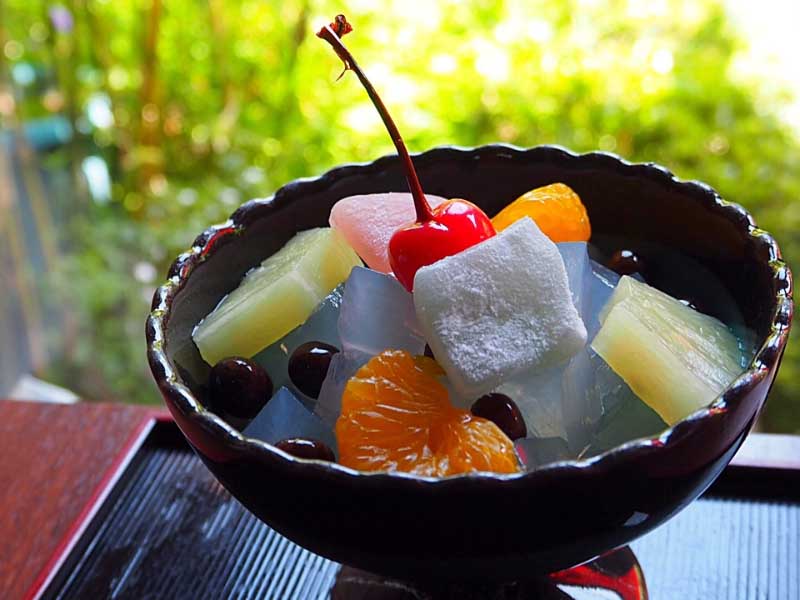
Sometimes adding other colorful liquids or fruit pieces will enhance simple water. In its most basic form, this cool delicacy is typically served in bowls with jelly cubes on the bottom and a layer of thick, black syrup prepared from unrefined sugar on top.
Mitsumame may be found in a wide range of various variants depending on extra toppings and seasonings. Various varieties of sliced fruit, ripe black soybeans, and chewy mochiko balls made of glutinous rice flour are the most typical toppings.
The cream Mitsumame served with a scoop of vanilla or green tea ice cream, is one of the most well-liked types. Mitsumame is one of the most popular summer sweets in Japan because it is easy and hydrating.
13. Uirō
Uirō is a delicious Japanese cake made from rice flour, water, and sugar. Traditionally, the cake is cooked until it acquires a chewy texture. It was first utilized in the 16th century as a component of Japanese tea rituals, a custom that is still followed today.

The cake can be flavored with things like matcha, chestnuts, strawberries, or azuki bean paste because there are many different varieties of it. Although it is formed from the same ingredients as mochi, Uirō is prepared differently. Rather than being crushed to make it sticky, mochi is instead put into a mold and steamed.
14. Higashi
Higashi is a traditional, pressed, dry Japanese sweet with a very long shelf life. They typically comprise sugar and rice flour and frequently have a moisture content of 10% or less. They are wagashi, which are typical little sweet delicacies from Japan.

The best type of higashi is thought to be produced using Wasabon (Japanese premium sugar). Since the candies are pressed into wooden molds, they take on the shape of the mold, which is typically a flower or other attractive, natural thing. This gives this Japanese candy its distinctive shape. The recipes for higashi, which are frequently served with tea, are generally closely kept trade secrets of the confectioneries that make them.
15. Rakugan
Traditional Japanese sweets known as rakugan are made in a wide variety of hues and forms to correspond with regional, seasonal, and festival themes. They are created by pressing sugar, soybean flour, and other powders into Kashigata, or traditional wooden molds.
Rakugan is a type of confection that may be considered in and of itself to be an art form. It is frequently drunk during celebrations like Christmas and tea ceremonies. Rakugan tastes like pure sugar since it resembles the usual sugar cubes used for tea in the West.
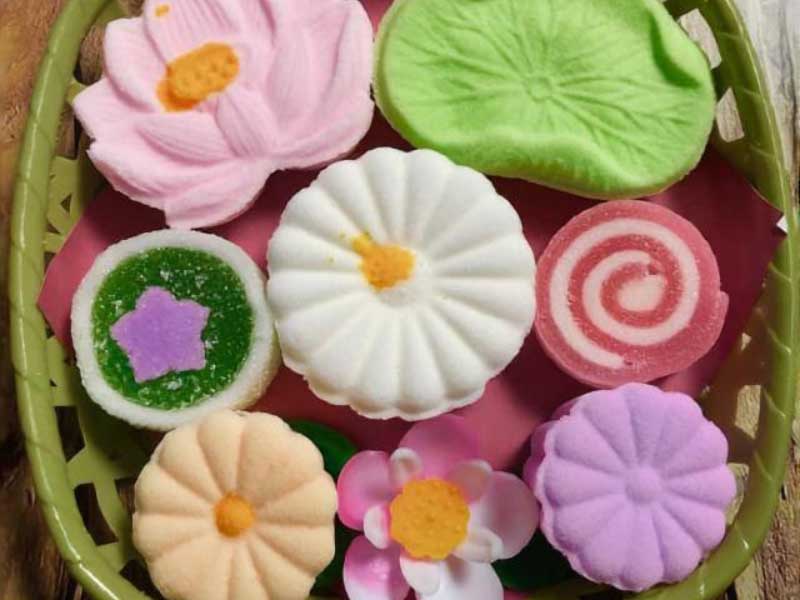
Rakugan is widely available at numerous stores and gift shops since it is so well-liked in Japan. Both the Tokushima region noted for the manufacturing of premium Wasanbon sugar, and the Kanazawa region of Japan are widely known for their rakugan confections.
16. Anmitsu
Agar cubes and Anko are used to make the classic Japanese confection known as Anmitsu (a translucent jelly with a slightly neutral flavor). While Mitsu (black syrup) or kinako (roasted soybean flour) are sometimes provided on the side, it is typically served in a bowl.

Other components frequently seen in Anmitsu include mochi, chestnuts, ice cream, peas, and other fruits. Its name comes from the Japanese terms an, which refers to delicious red bean paste, and Mitsu, which means molasses syrup. Animtsu is thought to have been created during the Meiji Period. It is now quite well-known and can be found in many Japanese restaurants, where it is customarily eaten with a spoon and fork. Anmitsu is a meal that is typically associated with the summer since it is reviving on hot, muggy days.
17. Yokan
Yokan is a Japanese confection that resembles a hard jelly. Red bean paste, sugar, and agar-agar are the ingredients. The jelly is prepared as long rectangular blocks that are then cut into smaller pieces for serving. The two primary types are Neri yokan, which is harder, and Mizu yokan, which is lighter in the summer and often served cold.
Yokan is most frequently made using red bean paste, although other common bases include chestnut, sweet potato, or kidney bean paste steeped with green tea. Yokan is adaptable, therefore there are currently many artisanal varieties with artistic appearances and unique flavors available in Japan.

Yokan is thought to have its roots in a traditional Chinese dish made with animal gelatin that was then adapted into a Japanese variant. Buddhist monks brought the custom of making the jelly-like dish, but he modified it to Japanese flavor by using agar-agar in place of the animal gelatin. Yokan is typically eaten as a sweet snack or as a dessert, and it is advised to enjoy it with a cup of cooling Japanese green tea.
18. Konpeitō
A common Japanese treat known as Konpeitō is a form of wagashi that is nearly completely comprised of sugar and is distinguished by its artistically unique shape and colors. Portuguese traders brought it to Japan in the sixteenth century. The Portuguese term confeitō, which describes a similar sweet dessert, is where the name Konpeitō actually comes from.

It typically takes between 7 and 20 days to make one Konpeitō by heating and spinning a little lump of sugar, which is then covered with more sugar every day until it crystallizes. Today, there are varieties like apple and cider in addition to the classic Konpeitō, which tastes like simple sugar.
It is frequently employed in tea ceremonies and while creating cakes for children. Konpeitō is also a typical present given to guests of the Imperial House of Japan, providing many travelers with a distinctive memento to take home.
19. Yatsuhashi
Yatsuhashi is a sort of Wagashi or traditional Japanese confections, that is frequently served with tea and sold mostly as souvenir sweets called Miyagegashi. It is one of the most well-known meibutsu, or regional specialty items, in Kyoto.
The most traditional Yatsuhashi is fashioned like a koto. This popular Kyoto meibutsu, which reflects hundreds of years of the city’s history and customs, originally debuted in 1689 and was named after Kengyō Yatsuhashi, a well-known Japanese harp player and composer of koto music.

Over time, more types were introduced by the Japanese omiyage or souvenir industry. The raw variant of this cookie, known as Nama Yatsuhashi, is often folded into a triangle and has a soft, almost mochi-like feel. Yaki Yatsuhashi is a crispy baked cookie with a cinnamon taste that is produced with sticky rice flour. It often comes wrapped around sweet red bean paste and flavored with green tea or black sesame, however it is also available in a variety of other tastes.
20. Zenzai
Japanese Zenzaiis a novel delicacy that blends mochi, a well-known sticky rice cake, with a hearty red bean soup. It can be prepared by boiling dry red beans or thinning Anko (red bean paste with added sugar). The texture of the soup might be either fully smooth or gritty.
Although diverse tastes, like orange zest, can be added to Zenzai, the flavor should normally be mild, earthy, and somewhat sweet. The hot, heated, or grilled mochi cakes are added to this filling liquid dessert just before serving.

Zenzai is typically served with sour items like pickled plums or kombu tea, which contrast wonderfully with the sweetness of the soup. Chopsticks and a spoon are used to consume this type of Japanese traditional sweet. Zenzai can be served cooled throughout the summer and is typically served with a few scoops of ice cream, despite being a classic and warming winter dessert that is typically consumed warm.
Different types of Zenzai may be found across Japan, including the Okinawa variety prepared with green beans and the soba Zenzai made with buckwheat dumplings. The dish is thought to have entered Japanese cuisine in the 18th century after sugar was introduced to the nation. Outside of Japan, China, North Korea, and Vietnam are the main countries where Zenzai and its variations are consumed.
>>> Read more: How To Buy From Mercari Japan with Janbox Proxy Service
Conclusion
The concepts of visual beauty and the changing of the seasons are heavily incorporated into Japanese culture and food. The texture, shape, and color of Japanese traditional sweets are equally as significant as the taste. It is evidence of the inventiveness and development of Japanese cuisine. There are almost unlimited options for sweets. Discover the taste and Japan’s rich history and culture with each mouthful!
Website: https://janbox.com
Email: [email protected]




